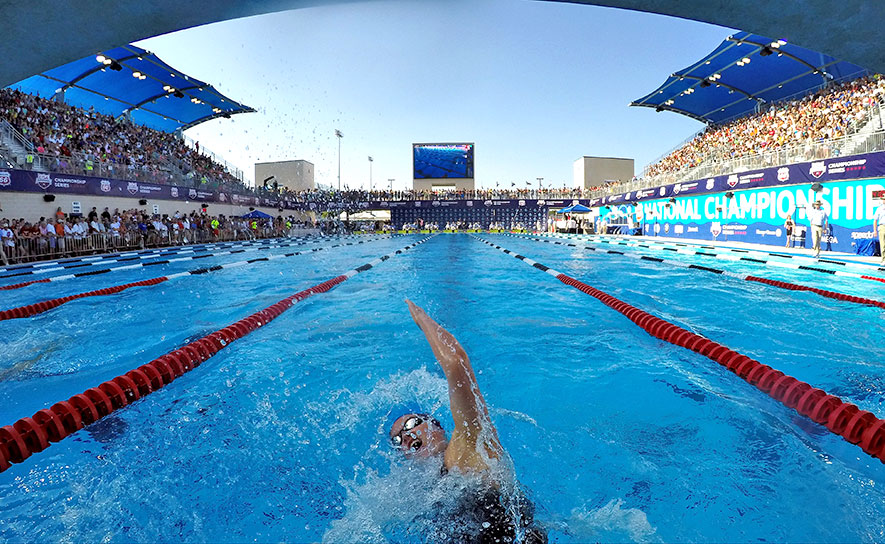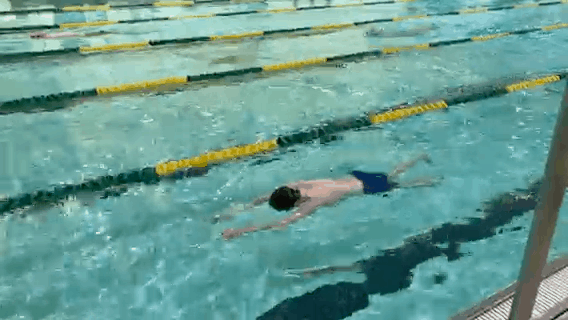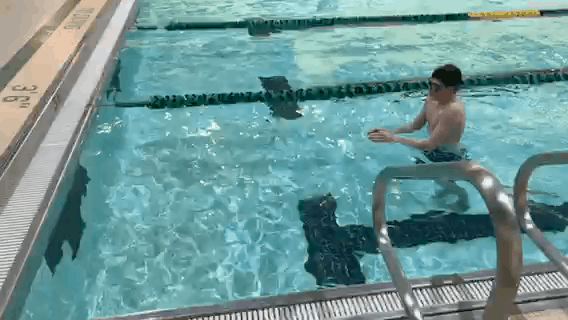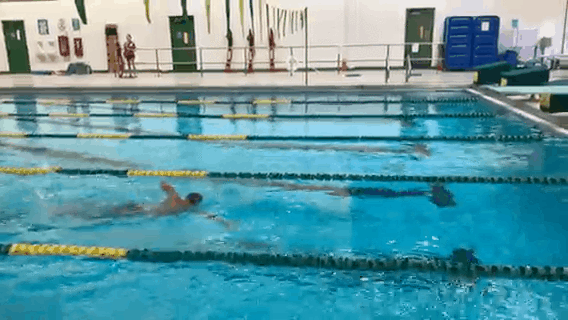USA Swimming News
Tuesday, October 27, 2020
Improving Your Flipturns - Mistakes, Fixes and Drills

by Emily Sampl//Contributor
Although swimmers might perform hundreds of flipturns or open turns during the course of a single swim practice, it can be more beneficial to break down a turn even further to emphasize proper timing and lightning-fast execution. After all, faster turns can cut tenths of a second or even full seconds off a swimmer’s time!
Head coaches Monique Shelton (Beach Cities Swimming/California) and Meghan O’Leary (Seward Tsunami Swim Club/Alaska) are here to share their knowledge on what it takes to have great turns – with common mistakes and how to fix them from Shelton, and a couple of fun turn drills from O’Leary.
Common Mistakes: Freestyle Flipturns
1. Slowing down going into the wall
2. Breathing into or out of the turn
3. Not getting into a small enough ball to rotate around quickly and get the feet into a powerful position
How to Fix It:
1. Speed before air. “You will hear our coaches saying this out loud every day,” said Shelton. “When that breath occurs in or out of the turn, you are losing valuable race and turn speed. Think speed before air.”
2. Plan your breathing pattern. “This shouldn’t be a surprise “ask” of your body on race day,” said Shelton. “Plan where you breathe and train it.”
3. Flippush. “Carry speed into your turn, look at the “+” on the wall, tuck that chin and whip the feet around to plant them on the wall for an explosive push – flippush – one fluid move,” Shelton said.
Common Mistakes: Backstroke Turns
1. Slow approach – fear of the wall, or missing the wall
2. Losing the last two strokes into the wall
3. Too shallow on the push-off
4. Circle swimming on the turn
How to Fix It:
1. Consistent stroke count is key, and performing turns at race speed frequently!
2. Work on mid-pool turns with no wall – make sure the lead arm grabs water before the trailing arm comes around for the final pull on the stomach.
3. Getting under the wave of water brought into the turn is critical – practice getting into that calm, deep water.
4. “Because of how we have to train, our kids habitually come in one door and leave out another – circle,” Shelton said. “Spend time having them go down the center of the lane and drive a straight line in and out of their turns.”
Common Mistakes: Open Turns
1. Loss of speed going into the wall – either caused by a short stroke or a long glide
2. Hanging out on the wall
3. Getting too high on the turn and turning sideways
4. Shallow push-offs coming off the wall
How to Fix It:
1. Know your stroke count!
2. This is usually a bad habit from practice – take time to do race pace turns and make fast turns an expectation in training.
3. “Go out the same door you went in” – keep your shoulders wet! Hold a kickboard at deck height and have the swimmers execute the turn without hitting their head.
4. Compare push-offs on the surface vs. deeper; have the swimmers race each other with one swimmer pushing off too shallow – this is always eye opening!
Drills:
Coach O’Leary has her swimmers practice these drills to improve their timing and speed on both open turns and flipturns.
#1: Focuses on not windmilling the arms during flipturns, and tucking the chin to the chest to flip while using their core. The swimmer holds a kickboard in each hand with the palms up, and they push off the wall for momentum while leaving the board in the same spot through the flip.

#2: A similar drill but for open turns, focuses on the knee drive to create a pivoting action. Swimmers lay on the surface and drive their knees toward their chest, slip arms to their sides then pivot onto their backs.

#3: Anther open turn drill – push off the bottom to create the speed that is redirected during the turn. The goal is to slip under the wake of water, and use the speed to turn.

#4: Underwater turns – these can be done doing full distances and for open turns or flipturns. Swimmers can dive down at the flags, kick into the wall and then do the turn deep enough underwater that their feet don’t break the surface. The water resistance slows them down and they’ll feel a lot of drag if their kicks aren’t tight. Also good for working on breath control!

Head coaches Monique Shelton (Beach Cities Swimming/California) and Meghan O’Leary (Seward Tsunami Swim Club/Alaska) are here to share their knowledge on what it takes to have great turns – with common mistakes and how to fix them from Shelton, and a couple of fun turn drills from O’Leary.
Common Mistakes: Freestyle Flipturns
1. Slowing down going into the wall
2. Breathing into or out of the turn
3. Not getting into a small enough ball to rotate around quickly and get the feet into a powerful position
How to Fix It:
1. Speed before air. “You will hear our coaches saying this out loud every day,” said Shelton. “When that breath occurs in or out of the turn, you are losing valuable race and turn speed. Think speed before air.”
2. Plan your breathing pattern. “This shouldn’t be a surprise “ask” of your body on race day,” said Shelton. “Plan where you breathe and train it.”
3. Flippush. “Carry speed into your turn, look at the “+” on the wall, tuck that chin and whip the feet around to plant them on the wall for an explosive push – flippush – one fluid move,” Shelton said.
Common Mistakes: Backstroke Turns
1. Slow approach – fear of the wall, or missing the wall
2. Losing the last two strokes into the wall
3. Too shallow on the push-off
4. Circle swimming on the turn
How to Fix It:
1. Consistent stroke count is key, and performing turns at race speed frequently!
2. Work on mid-pool turns with no wall – make sure the lead arm grabs water before the trailing arm comes around for the final pull on the stomach.
3. Getting under the wave of water brought into the turn is critical – practice getting into that calm, deep water.
4. “Because of how we have to train, our kids habitually come in one door and leave out another – circle,” Shelton said. “Spend time having them go down the center of the lane and drive a straight line in and out of their turns.”
Common Mistakes: Open Turns
1. Loss of speed going into the wall – either caused by a short stroke or a long glide
2. Hanging out on the wall
3. Getting too high on the turn and turning sideways
4. Shallow push-offs coming off the wall
How to Fix It:
1. Know your stroke count!
2. This is usually a bad habit from practice – take time to do race pace turns and make fast turns an expectation in training.
3. “Go out the same door you went in” – keep your shoulders wet! Hold a kickboard at deck height and have the swimmers execute the turn without hitting their head.
4. Compare push-offs on the surface vs. deeper; have the swimmers race each other with one swimmer pushing off too shallow – this is always eye opening!
Drills:
Coach O’Leary has her swimmers practice these drills to improve their timing and speed on both open turns and flipturns.
#1: Focuses on not windmilling the arms during flipturns, and tucking the chin to the chest to flip while using their core. The swimmer holds a kickboard in each hand with the palms up, and they push off the wall for momentum while leaving the board in the same spot through the flip.

#2: A similar drill but for open turns, focuses on the knee drive to create a pivoting action. Swimmers lay on the surface and drive their knees toward their chest, slip arms to their sides then pivot onto their backs.

#3: Anther open turn drill – push off the bottom to create the speed that is redirected during the turn. The goal is to slip under the wake of water, and use the speed to turn.

#4: Underwater turns – these can be done doing full distances and for open turns or flipturns. Swimmers can dive down at the flags, kick into the wall and then do the turn deep enough underwater that their feet don’t break the surface. The water resistance slows them down and they’ll feel a lot of drag if their kicks aren’t tight. Also good for working on breath control!

Related Articles
ARTICLE
How to Create Your Goal Pyramid with Paralympian Trevon Jenifer
Dec 30, 2025
ARTICLE
8 Tips on Goal Setting from Olympic Weightlifter Abby Raymond
Dec 23, 2025
ARTICLE
Consistency and Commitment: Olympian Chris Mazdzer on Goal Setting
Dec 18, 2025
ARTICLE
Do you know how to recover from change?
Nov 26, 2025
ARTICLE
8 Ways to Help Your Student-Athlete Recover from Change
Nov 18, 2025
ARTICLE
How Coaches Can Better Support Athletes After Change
Nov 13, 2025
ARTICLE
Should male and female athletes fuel differently?
Nov 3, 2025
ARTICLE
6 Ways to Set Boundaries that Support Athlete Well-Being
Oct 30, 2025
ARTICLE
Do you know how to practice mental recovery?
Oct 21, 2025
